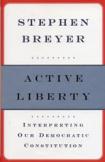Shared Authority
In Active Liberty Supreme Court Justice Stephen Breyer offers an alternative to Justice Antonin Scalia’s advocacy of text-focused statutory interpretation and a constitutional jurisprudence that takes its bearings from original intent. Instead, Breyer argues, statutory interpretation should look to the broad purposes legislators seek to promote, understood through legislative history and common sense as well as statutory language, and should read specific provisions in the manner most compatible with these purposes.
At the constitutional level, he argues, judges and justices should give more weight to the democratic character of the United States’ founding charter. He sums up his understanding of American democracy in the phrase active liberty, by which he means (1) a conception of legitimate authority based on the people themselves, (2) a conception of government in which the people participate and (3) institutions and practices, such as education and a free press, that enable the people to develop and exercise their capacity for self-government. Common to statutory and Constitution jurisprudence as Breyer understands it is an insistence on the legitimacy and importance of assessing the real-world consequences of competing interpretations, and on the responsibility of judges to read texts so as to maximize the extent to which the relevant public purposes are promoted.
Breyer offers not only an alternative to, but a critique of, Scalia’s jurisprudence. In the first place, he argues, the framers are not the source of the originalist approach. Rather, originalism is a contestable contemporary account of the kind of jurisprudence they would have favored. Second, originalism does not rule out judicial subjectivity to the extent that Scalia and his followers contend. Third, originalism does not reliably yield the clear rules originalists prize as essential to the rule of law. And finally, originalism can yield bad results, some of which are constitutional harms, like impeding the people’s ability to govern themselves effectively.
While Breyer succeeds in scoring a number of points against Scalia, his own theory is less than wholly persuasive. Begin with his central concept of active liberty. He offers it as a synthesis of Benjamin Constant’s famous distinction between the liberty of the ancients (direct public participation in governance) and the liberty of the moderns (protection against governmental oppression and tyranny, including abuses that occur when democratic majorities trample minority rights). The difficulty is that while the framers of the U.S. Constitution were determined to protect modern liberty, they were ambivalent at best about promoting ancient liberty. They were not impressed with the performance of popular governments at the state and local level in the years immediately following the Revolutionary War, and they regarded the Greek city-states as examples of instability and strife rather than models of public liberty.
To put it differently: the founders were staunch republicans who believed that all legitimate authority flows directly or indirectly from the people, but they were far from endorsing participatory democracy as the ideal of practical governance. Important constitutional institutions were designed as much to buffer public officials from popular pressure as to invite direct public participation in self-government.
A second difficulty: Whatever we think of active liberty, it is, as Breyer acknowledges, a single constitutional theme, one among many. In a book largely devoted to exploring constitutional purposes, it is remarkable that he pays no attention to the Preamble, the portion of the Constitution that enumerates core constitutional aims. There is no guarantee that these explicit purposes will always be compatible with Breyer’s preferred but inferred aim, and reason to believe that they are not. He is critical, for example, of the Rehnquist court’s federalism jurisprudence, especially its refusal to allow the federal government to supersede state and local authorities in time of emergency. But as recent discussions of the response to Hurricane Katrina have made clear, there are reasons to be wary of concentrating too much powerespecially military powerin the hands of the federal executive branch.
There are parallel difficulties with the interpretive weight Breyer ascribes to purposes and consequences. First, there is no guarantee that the instruments the people or the representatives devise will be designed well enough to serve their underlying purposes. The people can make mistakes. One might well argue, against Breyer, that the judiciary’s role is to enforce the law, point out the tension (where it exists) between ends and means and then leave it to the legislature and the people to correct mistakes.
Another difficulty is in attributing specific purposes to constitutional provisions. Breyer is sure, for example, that the purpose of the First Amendment’s Establishment Clause is to reduce religiously inspired social conflict. But as James Madison and Thomas Jefferson argued in their famous Memorial and Remonstrance, 18th-century anti-establishmentarians were at least as concerned with the protection of individual conscience as with minimizing social strife. Besides, the enforcement of basic rights, including rights of religion, can actually exacerbate social conflict. Should the Supreme Court shrink from enforcing them?
If the Constitution’s provisions often embody multiple purposes, by what criteria do we decide which purposes are the most relevant (Breyer’s term) in specific cases? At the least, Breyer owes his readers a fuller account of why we should prefer active liberty to other possibilities. After all, statutes may limit public information, conversation and participation without ceasing to be constitutionalbecause they serve other important constitutional purposes, such as promoting the common defense.
Breyer’s inadequately argued advocacy of active liberty as the core constitutional aim forces him in the end to endorse a neo-Periclean insistence on constant direct political participation as the duty of every citizen. That may be his ideal, but it was not that of the founders. Nor is it embraced today by a majority of his fellow citizens. From a democratic standpoint, this disagreement should give him pause. Oddly, it does not.
This article also appeared in print, under the headline “Shared Authority,” in the February 27, 2006, issue.








